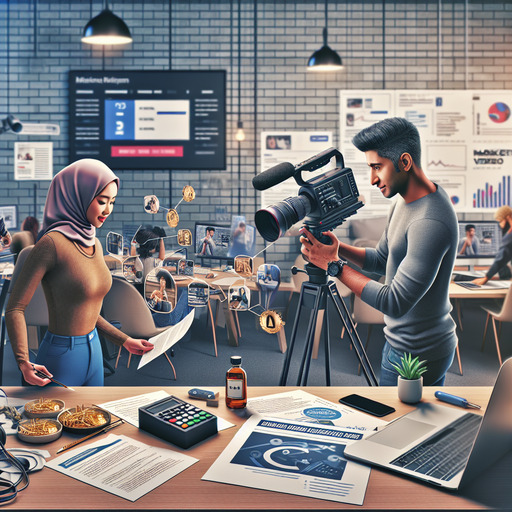
-
Table of Contents
Ready to elevate your brand? Discover the secrets to filming a high-quality marketing video for social media! Learn more here.
Introduction
Creating a high-quality marketing video for social media involves several key steps to ensure that your content is engaging, professional, and effective in reaching your target audience. First, define your video’s purpose and target audience to tailor your message appropriately. Next, plan your content meticulously by scripting your message, creating a storyboard, and organizing your shoot. Invest in good equipment, including a high-resolution camera, proper lighting, and clear audio recording devices, to enhance the production quality. Pay attention to the setting and background to ensure they align with your brand’s image. During filming, use stable shots, varied angles, and dynamic compositions to keep viewers interested. Post-production is crucial; edit your footage to create a cohesive narrative, add graphics or text overlays, and incorporate background music or sound effects to enhance the viewer’s experience. Finally, optimize your video for each social media platform by considering their specific requirements and best practices, such as video length, format, and captioning. By following these steps, you can produce a high-quality marketing video that effectively promotes your brand and engages your audience on social media.
How to Film a High-Quality Marketing Video for Social Media: Videography Tips from Professional Videography Services
Creating a high-quality marketing video for social media requires a blend of creativity, technical skill, and strategic planning. Professional videography services often emphasize the importance of pre-production, production, and post-production phases to ensure a polished final product. To begin with, pre-production is crucial as it lays the foundation for your video. This phase involves defining your target audience, setting clear objectives, and crafting a compelling script. By understanding who you are speaking to and what you aim to achieve, you can tailor your content to resonate with viewers and drive engagement.
Transitioning to the production phase, the importance of high-quality equipment cannot be overstated. Professional videography services recommend using a good camera, proper lighting, and clear audio equipment. While smartphones have advanced significantly, investing in a DSLR or mirrorless camera can elevate the visual quality of your video. Equally important is lighting; natural light is ideal, but if shooting indoors, softbox lights can help eliminate harsh shadows and create a professional look. Clear audio is another critical component; using an external microphone can significantly improve sound quality, making your message more understandable and engaging.
Moreover, framing and composition play a vital role in capturing visually appealing footage. The rule of thirds is a fundamental principle in videography, suggesting that placing your subject off-center can create a more balanced and interesting shot. Additionally, maintaining a steady camera is essential to avoid distracting your audience. Using a tripod or a gimbal can help achieve smooth, stable shots, enhancing the overall professionalism of your video.
As you move into the post-production phase, editing becomes the key to transforming raw footage into a cohesive and engaging story. Professional videography services often utilize advanced editing software like Adobe Premiere Pro or Final Cut Pro to refine their videos. However, user-friendly options like iMovie or DaVinci Resolve are also available for beginners. During editing, focus on trimming unnecessary content, adding transitions, and incorporating graphics or text to emphasize key points. Music and sound effects can also enhance the emotional impact of your video, but ensure they complement rather than overpower your message.
Furthermore, optimizing your video for social media platforms is essential for maximizing reach and engagement. Each platform has its own specifications and best practices; for instance, Instagram favors shorter, visually striking videos, while YouTube allows for longer, more in-depth content. Tailoring your video to fit the platform’s format and audience preferences can significantly boost its effectiveness. Additionally, including captions can make your video accessible to a broader audience, including those who watch without sound.
Finally, promoting your video strategically can amplify its impact. Sharing your video across multiple platforms, collaborating with influencers, and engaging with your audience through comments and shares can increase visibility and drive engagement. Professional videography services often highlight the importance of analyzing performance metrics to understand what works and what doesn’t. By reviewing data such as view counts, engagement rates, and audience demographics, you can refine your approach and create even more effective videos in the future.
In conclusion, filming a high-quality marketing video for social media involves meticulous planning, technical proficiency, and strategic promotion. By following these tips from professional videography services, you can create compelling content that captures attention, conveys your message effectively, and drives meaningful engagement.
Q&A
1. **What equipment do I need to film a high-quality marketing video for social media?**
– **Camera**: A DSLR, mirrorless camera, or a high-quality smartphone camera.
– **Microphone**: External microphones like lavalier, shotgun, or USB microphones for clear audio.
– **Lighting**: Softbox lights, ring lights, or natural lighting to ensure proper illumination.
– **Tripod/Stabilizer**: To keep the camera steady and avoid shaky footage.
– **Editing Software**: Programs like Adobe Premiere Pro, Final Cut Pro, or mobile apps like iMovie or InShot for post-production.
– **Backdrop/Props**: Depending on the theme, use relevant backdrops and props to enhance the visual appeal.
– **Script/Storyboard**: Plan your content and shots to ensure a coherent and engaging video.